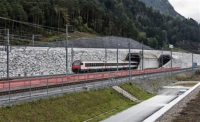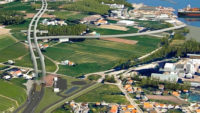Now that 17 years of construction to build the world’s longest tunnel is ramping down, a massive project to expand Alpine infrastructure soon will launch.
A tunnel-boring machine is about to start the pilot bore on the Mont Cenis base tunnel—located between Saint-Martin-de-la-Porte, France, and Susa, Italy—on the new Lyon-Turin railroad. At 57 kilometers, it will match the current world record-holder, Switzerland’s twin-bore Gotthard base tunnel, which was formally taken over on June 1 by the Swiss Federal Railways.
Tunnel workers now will turn to Saint-Martin-de-la-Porte, in southeastern France, where the TBM—supplied by locally based NFM Technologies, Le Creusot—is due to start driving the pilot this summer, says a spokesman for Tunnel Euralpin Lyon-Turin (TELT), the binational company responsible for the new crossing.
After years of planning, the project’s future was safeguarded this March by an agreement between the two governments at a summit conference in Venice. Officials confirmed the forecast cost of about $9.5 billion and agreed to share any future hikes equally. Otherwise, France will cover about 42% of the base-tunnel cost, and Italy will foot the rest.
The governments also agreed to adopt Italian procurement measures—an unusual move for France—to avoid corruption on the large contracts, due to be bid next year.
Infrastructure officials in a post-summit statement affirmed their intention to introduce legislation soon in both countries to “fight in the strongest terms against organized crime and to prevent the risks of Mafia infiltration.”
With several exploratory shafts and adits, or vertical and horizontal passages, already done, a team of four French and Italian contractors, led by Paris-based Spie Batignolles TPCI, will use an 11.2-meter-dia TBM to drive the 9-km pilot bore to the portal.
With that work in hand and subject to parliamentary ratification in both countries, the team is ready to start serious procurement, aiming for a 2029 completion date, says the spokesman. With the Gotthard tunnel contract ended, two of the three major tunnels on Switzerland’s New Railway Link through the Alps (NRLA) program are now done, and only the 15.4-km-long Ceneri Base Tunnel is still under construction.
More Underground Milestones
Since starting Gotthard work in May 2003, four TBMs displaced some 10.5 million cu m of rock while boring 75% of the 150 km of tunnel drives—the rest was removed by drill-and-blast. A $1.7-billion railroad-systems contract followed the civil work, leading to the recent handover before heads of state and other dignitaries.
The Gotthard tunnel alone will shave 30 minutes from the roughly 300-km Zurich-Milan rail journey. Another 30 minutes will be clipped off the journey when the Ceneri tunnel, to the south, opens in 2020.
A 2013 legal challenge over the Ceneri fit-out contract delayed the originally scheduled 2019 opening, according to project owner AlpTransit Gotthard S.A., Lucerne.
Since the long and complicated NRLA program started, all planned handover dates have shifted and for both directions. Working up to 2 km below the mountain surface in variable rock as hot as 50°C was never going to be trouble-free.
When key geological investigations were starting in 1993, the target completion date was put at 2007, says AlpTransit’s chief spokesman Ambros Zgraggen. After work started in 1999, completion shifted to 2012. Over the years, the handover targets slipped to 2014, then to 2017, before improving to this year.
Meanwhile, the Gotthard’s construction-cost forecast rose (at constant prices) to $6 billion from $5 billion in 1998 to around $10 billion today, says Zgraggen.
Conceived soon after World War II, the Gotthard is the largest of three rail tunnels in the NRLA. The 34.8-km-long Lötschberg was the first to open, in December 2007 (ENR 7/15/02 p. 28). The Swiss parliament in 1998 approved a total NRLA budget of $19.2 billion, including $13.4 billion for all aspects of the Gotthard.
The Gotthard’s twin bores are set some 40 m apart and linked with cross-passages at 325 m intervals. Most of the tunneling was done with four hard-rock TBMs, with diameters ranging from 8.8 m to 9.6 m.
To handle all the tunneling, AlpTransit recruited TAT for more than half the tunnel—31.4 km—from the south portal, including the Bodio and Fadio sections. Zschokke Locher A.G., Zurich, led the team, which included Impregilo S.p.A., Milan, and Hochtief A.G., Essen.
The Transco-Sedrun joint venture, led by Batigroup A.G. Tunnelbau, Zurich, built the 8.5-km Sedrun section. Bilfinger & Berger Bau A.G., Munich, and others were also on the team. The AGN joint venture, led by Austria’s Strabag A.G., handled the remaining 19.2 km to the north portal.
AlpTransit started awarding the main tunneling contracts in June 2001; the first 1 km of drill-and-blast tunnel was completed that August at Bodio to the south. Machine boring began at Amsteg in March 2003.
Soon after starting, two TBMs hit faulted, brittle rock that was too soft for the gripper machine, according to their supplier, Germany’s Herrenknecht A.G, Schwanau. The TBMs needed good rock at the rear of the shield to grip and thrust from. After months of slow progress, the TBMs left the fault zone in August 2003.
TBM crews completed the 11.3-km Amsteg-Sedrun drives in June and October 2006. Then, the machines were refurbished for the 7.8-km south drive, from the Erstfeld portal to Amsteg. They broke through in June and September 2009; along the way, they achieved a record 56 m advance in 24 hours.
The southern pair of TBMs completed the 15.9-km Bodio-Faido section in September and October 2006. Then, according to Herrenknecht, their diameters were raised to 9.4 m to navigate through the difficult, 150-m Piora Basin, described as a funnel-shaped formation containing sugar-like dolomite and high-pressure water. The machines holed through in October 2010 and March 2011.
Construction and engineering teams walked the full, 57-km length of the tunnel—a route that takes trains and buses six hours—for the first time in August 2013. As part of its $1.7-billion railroad-systems contract, the consortium Transtec Gotthard placed the last sleeper in October 2014, completing 290 km of track in 39 months.







